Cultural Safety Essay: Addressing Indigenous Healthcare in Australia
VerifiedAdded on 2023/01/13
|14
|4218
|35
Essay
AI Summary
This essay, prepared by a student, delves into the critical concept of cultural safety within the context of Australian nursing and healthcare, particularly focusing on the well-being of Indigenous populations. The essay begins by defining and differentiating between personal and institutional racism, exploring how white privilege subtly influences the clinical environment. It emphasizes the significance of cultural safety over cultural competence, highlighting how awareness of one's own cultural biases is crucial for providing equitable care. The essay then analyzes a specific article on social determinants of health, relating it to the disparities faced by Indigenous Australians. Furthermore, it examines the historical context of institutional racism, referencing key events like the 1967 referendum and ongoing challenges within healthcare and employment. The essay also addresses the insufficiency of current health standards and the need for culturally safe practices, advocating for curriculum changes and communication strategies to reduce racism. Finally, the student reflects on their learning, acknowledging personal biases and the impact of the course on their understanding of Indigenous health and the healthcare system, and how to improve the same.
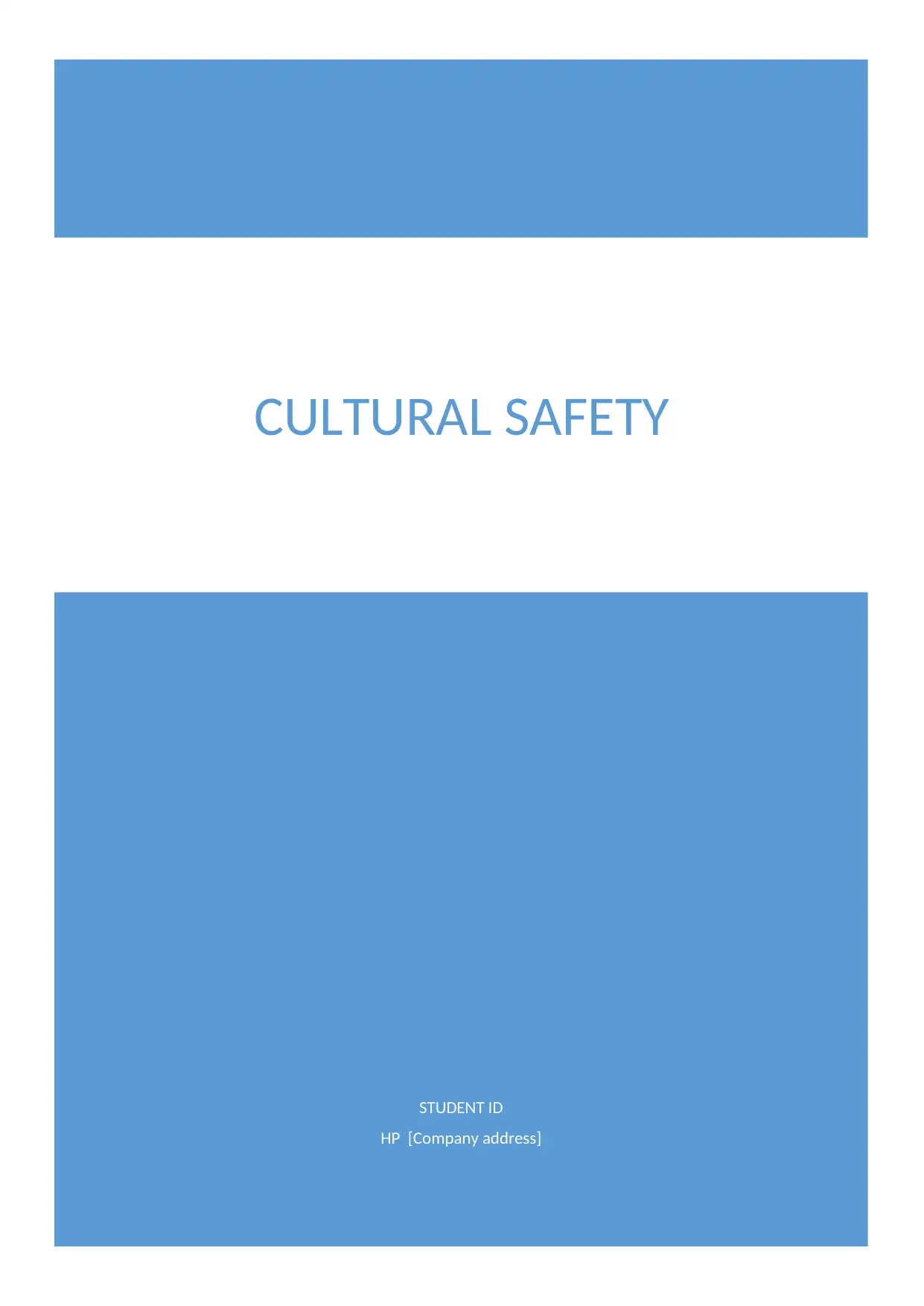
STUDENT ID
HP [Company address]
CULTURAL SAFETY
HP [Company address]
CULTURAL SAFETY
Paraphrase This Document
Need a fresh take? Get an instant paraphrase of this document with our AI Paraphraser
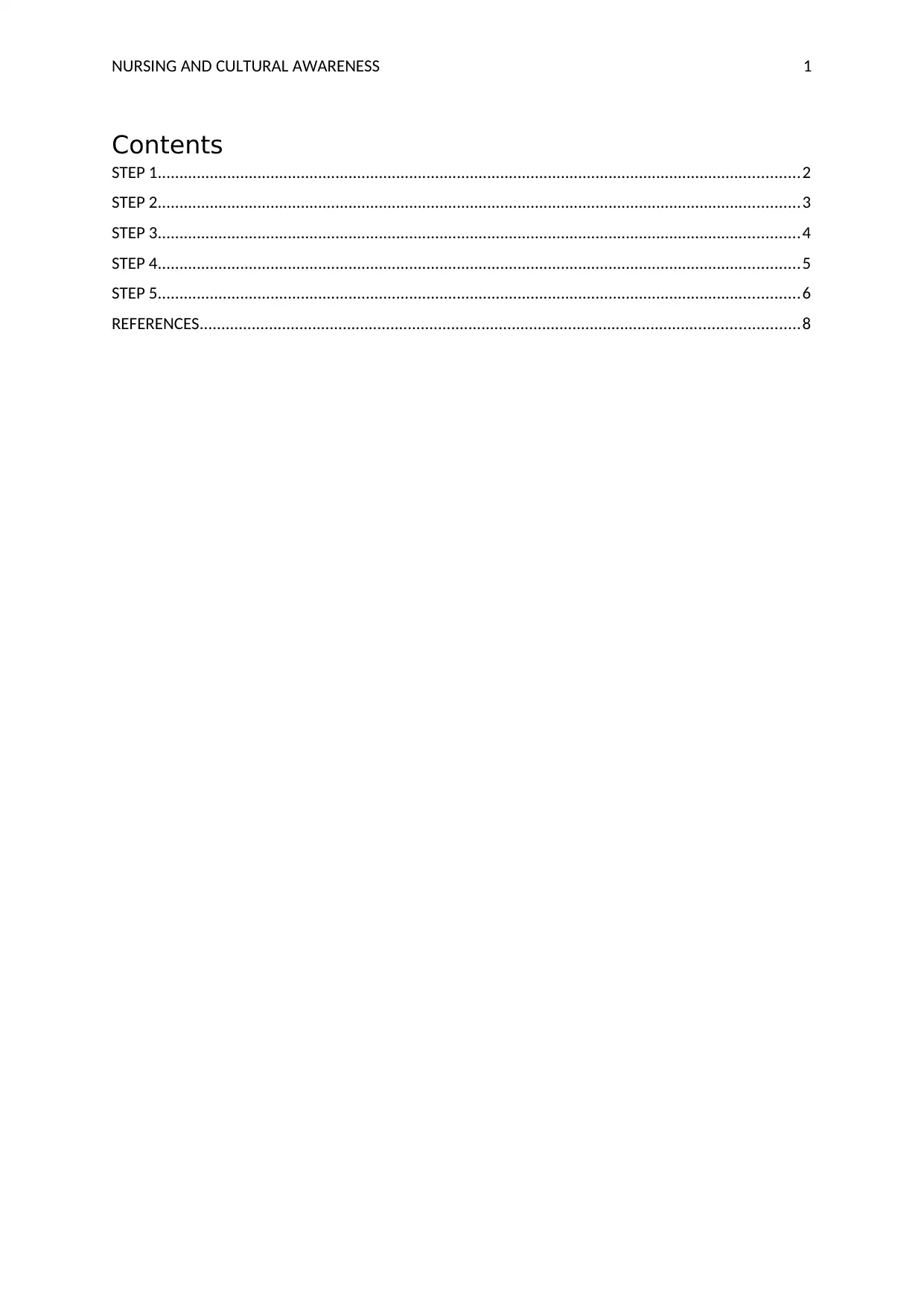
NURSING AND CULTURAL AWARENESS 1
Contents
STEP 1....................................................................................................................................................2
STEP 2....................................................................................................................................................3
STEP 3....................................................................................................................................................4
STEP 4....................................................................................................................................................5
STEP 5....................................................................................................................................................6
REFERENCES..........................................................................................................................................8
Contents
STEP 1....................................................................................................................................................2
STEP 2....................................................................................................................................................3
STEP 3....................................................................................................................................................4
STEP 4....................................................................................................................................................5
STEP 5....................................................................................................................................................6
REFERENCES..........................................................................................................................................8
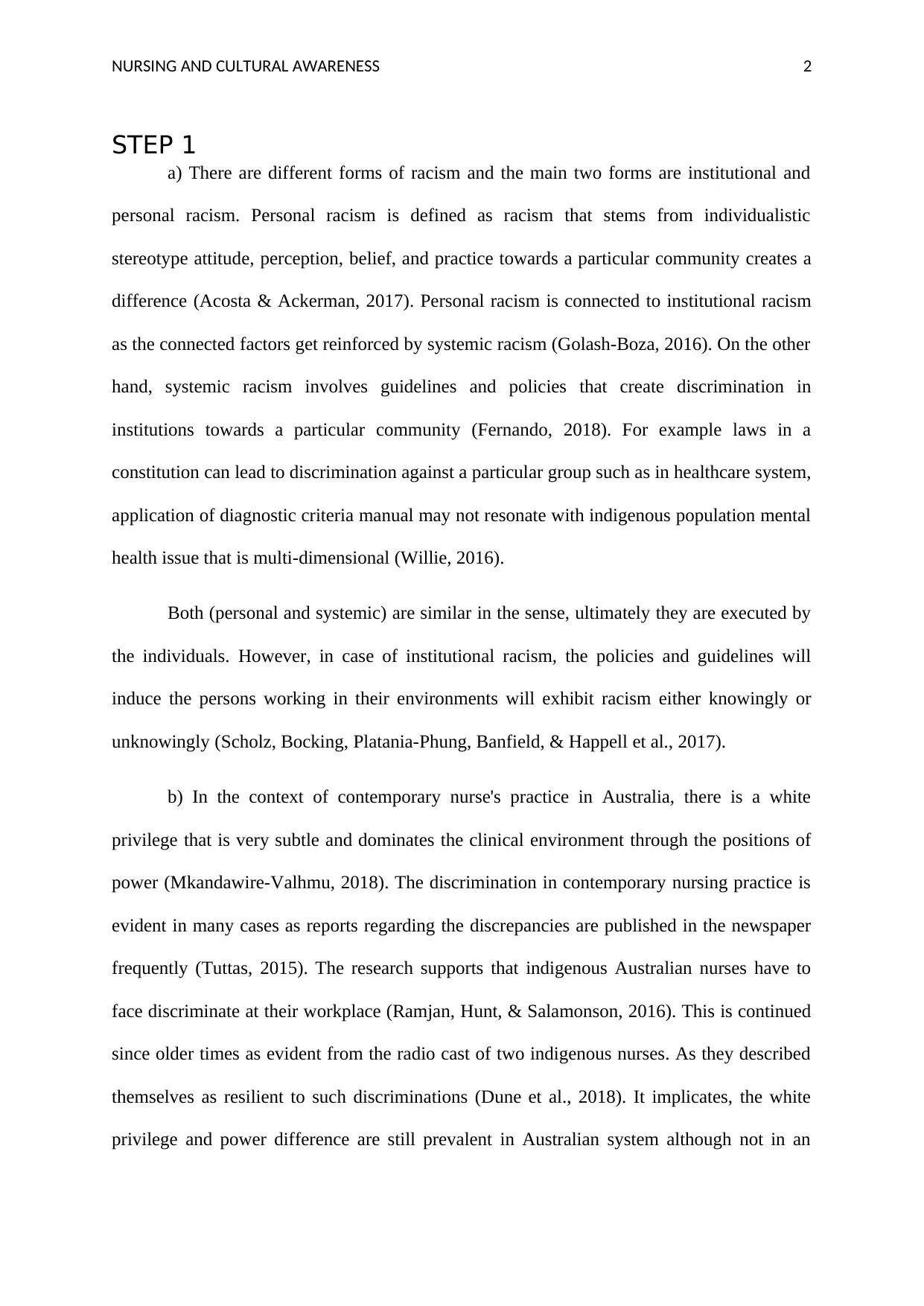
NURSING AND CULTURAL AWARENESS 2
STEP 1
a) There are different forms of racism and the main two forms are institutional and
personal racism. Personal racism is defined as racism that stems from individualistic
stereotype attitude, perception, belief, and practice towards a particular community creates a
difference (Acosta & Ackerman, 2017). Personal racism is connected to institutional racism
as the connected factors get reinforced by systemic racism (Golash-Boza, 2016). On the other
hand, systemic racism involves guidelines and policies that create discrimination in
institutions towards a particular community (Fernando, 2018). For example laws in a
constitution can lead to discrimination against a particular group such as in healthcare system,
application of diagnostic criteria manual may not resonate with indigenous population mental
health issue that is multi-dimensional (Willie, 2016).
Both (personal and systemic) are similar in the sense, ultimately they are executed by
the individuals. However, in case of institutional racism, the policies and guidelines will
induce the persons working in their environments will exhibit racism either knowingly or
unknowingly (Scholz, Bocking, Platania-Phung, Banfield, & Happell et al., 2017).
b) In the context of contemporary nurse's practice in Australia, there is a white
privilege that is very subtle and dominates the clinical environment through the positions of
power (Mkandawire-Valhmu, 2018). The discrimination in contemporary nursing practice is
evident in many cases as reports regarding the discrepancies are published in the newspaper
frequently (Tuttas, 2015). The research supports that indigenous Australian nurses have to
face discriminate at their workplace (Ramjan, Hunt, & Salamonson, 2016). This is continued
since older times as evident from the radio cast of two indigenous nurses. As they described
themselves as resilient to such discriminations (Dune et al., 2018). It implicates, the white
privilege and power difference are still prevalent in Australian system although not in an
STEP 1
a) There are different forms of racism and the main two forms are institutional and
personal racism. Personal racism is defined as racism that stems from individualistic
stereotype attitude, perception, belief, and practice towards a particular community creates a
difference (Acosta & Ackerman, 2017). Personal racism is connected to institutional racism
as the connected factors get reinforced by systemic racism (Golash-Boza, 2016). On the other
hand, systemic racism involves guidelines and policies that create discrimination in
institutions towards a particular community (Fernando, 2018). For example laws in a
constitution can lead to discrimination against a particular group such as in healthcare system,
application of diagnostic criteria manual may not resonate with indigenous population mental
health issue that is multi-dimensional (Willie, 2016).
Both (personal and systemic) are similar in the sense, ultimately they are executed by
the individuals. However, in case of institutional racism, the policies and guidelines will
induce the persons working in their environments will exhibit racism either knowingly or
unknowingly (Scholz, Bocking, Platania-Phung, Banfield, & Happell et al., 2017).
b) In the context of contemporary nurse's practice in Australia, there is a white
privilege that is very subtle and dominates the clinical environment through the positions of
power (Mkandawire-Valhmu, 2018). The discrimination in contemporary nursing practice is
evident in many cases as reports regarding the discrepancies are published in the newspaper
frequently (Tuttas, 2015). The research supports that indigenous Australian nurses have to
face discriminate at their workplace (Ramjan, Hunt, & Salamonson, 2016). This is continued
since older times as evident from the radio cast of two indigenous nurses. As they described
themselves as resilient to such discriminations (Dune et al., 2018). It implicates, the white
privilege and power difference are still prevalent in Australian system although not in an
⊘ This is a preview!⊘
Do you want full access?
Subscribe today to unlock all pages.

Trusted by 1+ million students worldwide
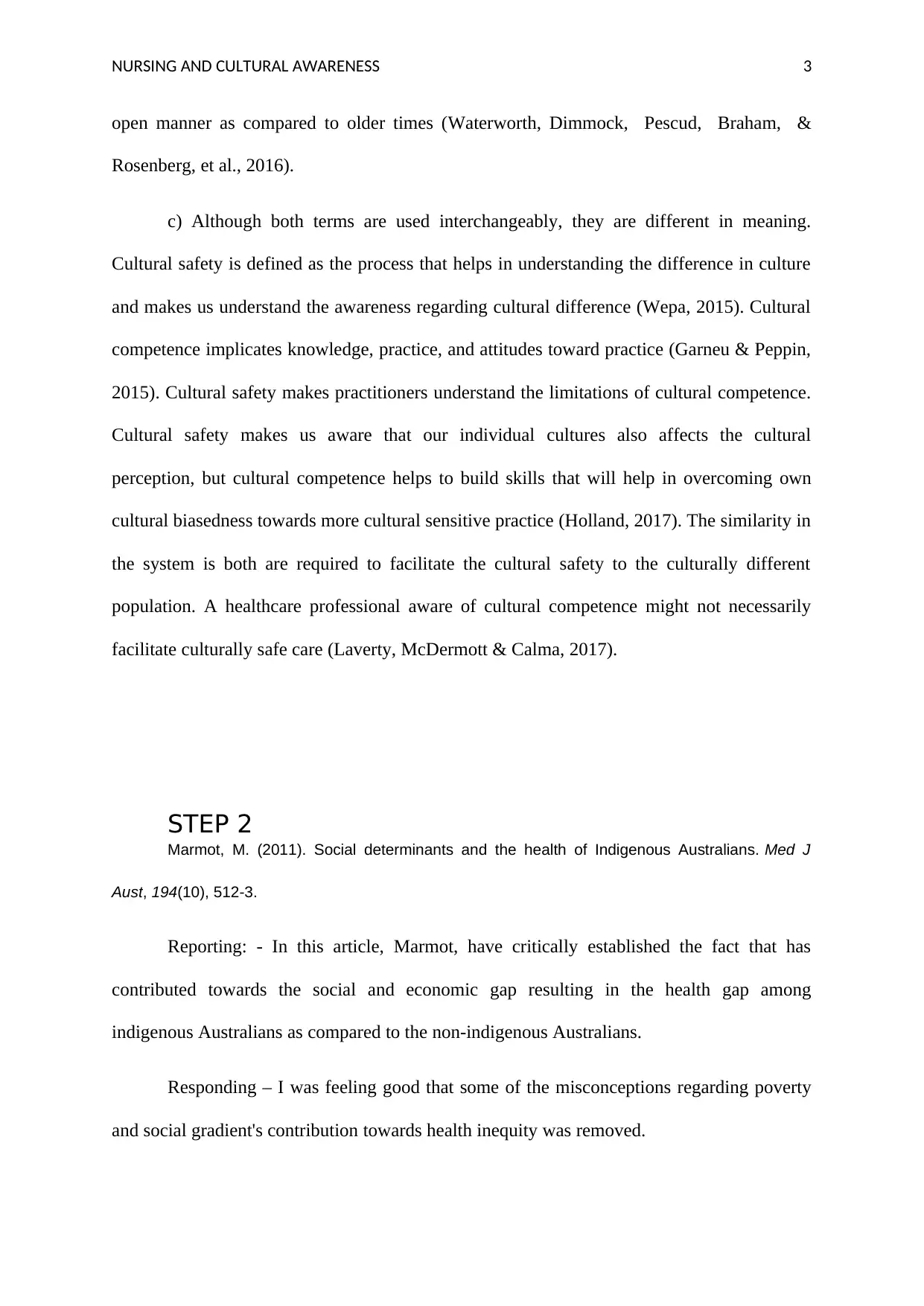
NURSING AND CULTURAL AWARENESS 3
open manner as compared to older times (Waterworth, Dimmock, Pescud, Braham, &
Rosenberg, et al., 2016).
c) Although both terms are used interchangeably, they are different in meaning.
Cultural safety is defined as the process that helps in understanding the difference in culture
and makes us understand the awareness regarding cultural difference (Wepa, 2015). Cultural
competence implicates knowledge, practice, and attitudes toward practice (Garneu & Peppin,
2015). Cultural safety makes practitioners understand the limitations of cultural competence.
Cultural safety makes us aware that our individual cultures also affects the cultural
perception, but cultural competence helps to build skills that will help in overcoming own
cultural biasedness towards more cultural sensitive practice (Holland, 2017). The similarity in
the system is both are required to facilitate the cultural safety to the culturally different
population. A healthcare professional aware of cultural competence might not necessarily
facilitate culturally safe care (Laverty, McDermott & Calma, 2017).
STEP 2
Marmot, M. (2011). Social determinants and the health of Indigenous Australians. Med J
Aust, 194(10), 512-3.
Reporting: - In this article, Marmot, have critically established the fact that has
contributed towards the social and economic gap resulting in the health gap among
indigenous Australians as compared to the non-indigenous Australians.
Responding – I was feeling good that some of the misconceptions regarding poverty
and social gradient's contribution towards health inequity was removed.
open manner as compared to older times (Waterworth, Dimmock, Pescud, Braham, &
Rosenberg, et al., 2016).
c) Although both terms are used interchangeably, they are different in meaning.
Cultural safety is defined as the process that helps in understanding the difference in culture
and makes us understand the awareness regarding cultural difference (Wepa, 2015). Cultural
competence implicates knowledge, practice, and attitudes toward practice (Garneu & Peppin,
2015). Cultural safety makes practitioners understand the limitations of cultural competence.
Cultural safety makes us aware that our individual cultures also affects the cultural
perception, but cultural competence helps to build skills that will help in overcoming own
cultural biasedness towards more cultural sensitive practice (Holland, 2017). The similarity in
the system is both are required to facilitate the cultural safety to the culturally different
population. A healthcare professional aware of cultural competence might not necessarily
facilitate culturally safe care (Laverty, McDermott & Calma, 2017).
STEP 2
Marmot, M. (2011). Social determinants and the health of Indigenous Australians. Med J
Aust, 194(10), 512-3.
Reporting: - In this article, Marmot, have critically established the fact that has
contributed towards the social and economic gap resulting in the health gap among
indigenous Australians as compared to the non-indigenous Australians.
Responding – I was feeling good that some of the misconceptions regarding poverty
and social gradient's contribution towards health inequity was removed.
Paraphrase This Document
Need a fresh take? Get an instant paraphrase of this document with our AI Paraphraser
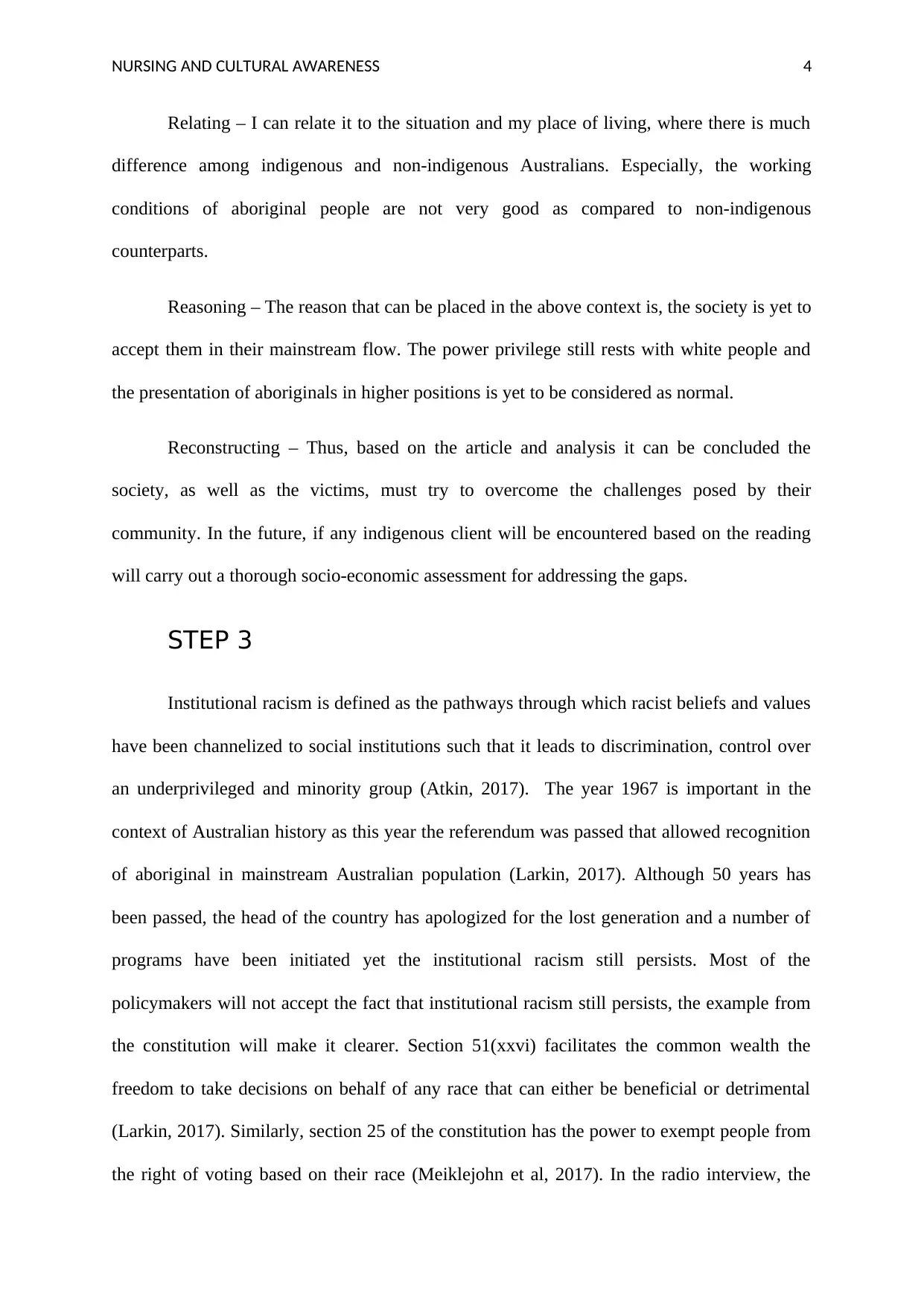
NURSING AND CULTURAL AWARENESS 4
Relating – I can relate it to the situation and my place of living, where there is much
difference among indigenous and non-indigenous Australians. Especially, the working
conditions of aboriginal people are not very good as compared to non-indigenous
counterparts.
Reasoning – The reason that can be placed in the above context is, the society is yet to
accept them in their mainstream flow. The power privilege still rests with white people and
the presentation of aboriginals in higher positions is yet to be considered as normal.
Reconstructing – Thus, based on the article and analysis it can be concluded the
society, as well as the victims, must try to overcome the challenges posed by their
community. In the future, if any indigenous client will be encountered based on the reading
will carry out a thorough socio-economic assessment for addressing the gaps.
STEP 3
Institutional racism is defined as the pathways through which racist beliefs and values
have been channelized to social institutions such that it leads to discrimination, control over
an underprivileged and minority group (Atkin, 2017). The year 1967 is important in the
context of Australian history as this year the referendum was passed that allowed recognition
of aboriginal in mainstream Australian population (Larkin, 2017). Although 50 years has
been passed, the head of the country has apologized for the lost generation and a number of
programs have been initiated yet the institutional racism still persists. Most of the
policymakers will not accept the fact that institutional racism still persists, the example from
the constitution will make it clearer. Section 51(xxvi) facilitates the common wealth the
freedom to take decisions on behalf of any race that can either be beneficial or detrimental
(Larkin, 2017). Similarly, section 25 of the constitution has the power to exempt people from
the right of voting based on their race (Meiklejohn et al, 2017). In the radio interview, the
Relating – I can relate it to the situation and my place of living, where there is much
difference among indigenous and non-indigenous Australians. Especially, the working
conditions of aboriginal people are not very good as compared to non-indigenous
counterparts.
Reasoning – The reason that can be placed in the above context is, the society is yet to
accept them in their mainstream flow. The power privilege still rests with white people and
the presentation of aboriginals in higher positions is yet to be considered as normal.
Reconstructing – Thus, based on the article and analysis it can be concluded the
society, as well as the victims, must try to overcome the challenges posed by their
community. In the future, if any indigenous client will be encountered based on the reading
will carry out a thorough socio-economic assessment for addressing the gaps.
STEP 3
Institutional racism is defined as the pathways through which racist beliefs and values
have been channelized to social institutions such that it leads to discrimination, control over
an underprivileged and minority group (Atkin, 2017). The year 1967 is important in the
context of Australian history as this year the referendum was passed that allowed recognition
of aboriginal in mainstream Australian population (Larkin, 2017). Although 50 years has
been passed, the head of the country has apologized for the lost generation and a number of
programs have been initiated yet the institutional racism still persists. Most of the
policymakers will not accept the fact that institutional racism still persists, the example from
the constitution will make it clearer. Section 51(xxvi) facilitates the common wealth the
freedom to take decisions on behalf of any race that can either be beneficial or detrimental
(Larkin, 2017). Similarly, section 25 of the constitution has the power to exempt people from
the right of voting based on their race (Meiklejohn et al, 2017). In the radio interview, the
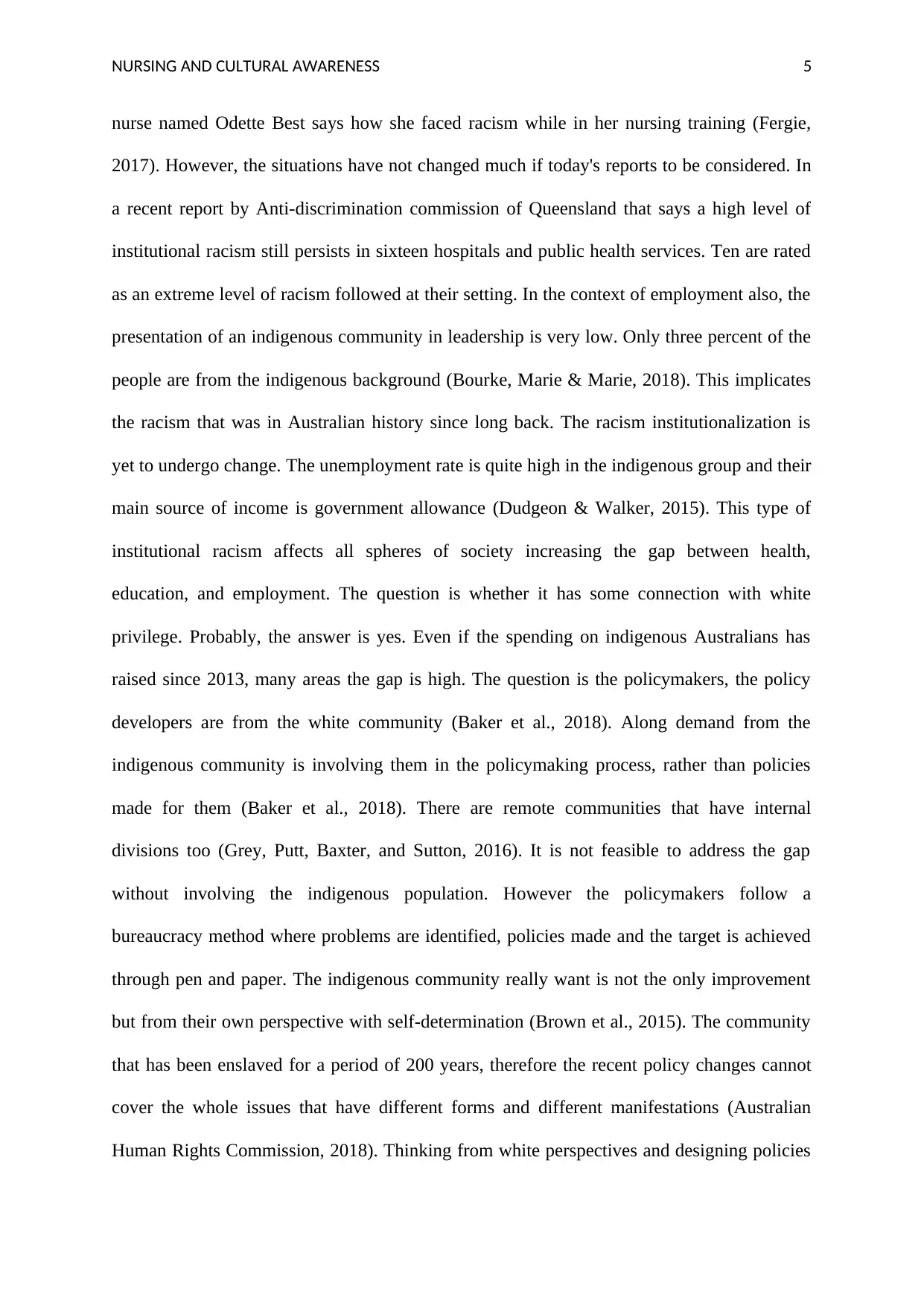
NURSING AND CULTURAL AWARENESS 5
nurse named Odette Best says how she faced racism while in her nursing training (Fergie,
2017). However, the situations have not changed much if today's reports to be considered. In
a recent report by Anti-discrimination commission of Queensland that says a high level of
institutional racism still persists in sixteen hospitals and public health services. Ten are rated
as an extreme level of racism followed at their setting. In the context of employment also, the
presentation of an indigenous community in leadership is very low. Only three percent of the
people are from the indigenous background (Bourke, Marie & Marie, 2018). This implicates
the racism that was in Australian history since long back. The racism institutionalization is
yet to undergo change. The unemployment rate is quite high in the indigenous group and their
main source of income is government allowance (Dudgeon & Walker, 2015). This type of
institutional racism affects all spheres of society increasing the gap between health,
education, and employment. The question is whether it has some connection with white
privilege. Probably, the answer is yes. Even if the spending on indigenous Australians has
raised since 2013, many areas the gap is high. The question is the policymakers, the policy
developers are from the white community (Baker et al., 2018). Along demand from the
indigenous community is involving them in the policymaking process, rather than policies
made for them (Baker et al., 2018). There are remote communities that have internal
divisions too (Grey, Putt, Baxter, and Sutton, 2016). It is not feasible to address the gap
without involving the indigenous population. However the policymakers follow a
bureaucracy method where problems are identified, policies made and the target is achieved
through pen and paper. The indigenous community really want is not the only improvement
but from their own perspective with self-determination (Brown et al., 2015). The community
that has been enslaved for a period of 200 years, therefore the recent policy changes cannot
cover the whole issues that have different forms and different manifestations (Australian
Human Rights Commission, 2018). Thinking from white perspectives and designing policies
nurse named Odette Best says how she faced racism while in her nursing training (Fergie,
2017). However, the situations have not changed much if today's reports to be considered. In
a recent report by Anti-discrimination commission of Queensland that says a high level of
institutional racism still persists in sixteen hospitals and public health services. Ten are rated
as an extreme level of racism followed at their setting. In the context of employment also, the
presentation of an indigenous community in leadership is very low. Only three percent of the
people are from the indigenous background (Bourke, Marie & Marie, 2018). This implicates
the racism that was in Australian history since long back. The racism institutionalization is
yet to undergo change. The unemployment rate is quite high in the indigenous group and their
main source of income is government allowance (Dudgeon & Walker, 2015). This type of
institutional racism affects all spheres of society increasing the gap between health,
education, and employment. The question is whether it has some connection with white
privilege. Probably, the answer is yes. Even if the spending on indigenous Australians has
raised since 2013, many areas the gap is high. The question is the policymakers, the policy
developers are from the white community (Baker et al., 2018). Along demand from the
indigenous community is involving them in the policymaking process, rather than policies
made for them (Baker et al., 2018). There are remote communities that have internal
divisions too (Grey, Putt, Baxter, and Sutton, 2016). It is not feasible to address the gap
without involving the indigenous population. However the policymakers follow a
bureaucracy method where problems are identified, policies made and the target is achieved
through pen and paper. The indigenous community really want is not the only improvement
but from their own perspective with self-determination (Brown et al., 2015). The community
that has been enslaved for a period of 200 years, therefore the recent policy changes cannot
cover the whole issues that have different forms and different manifestations (Australian
Human Rights Commission, 2018). Thinking from white perspectives and designing policies
⊘ This is a preview!⊘
Do you want full access?
Subscribe today to unlock all pages.

Trusted by 1+ million students worldwide
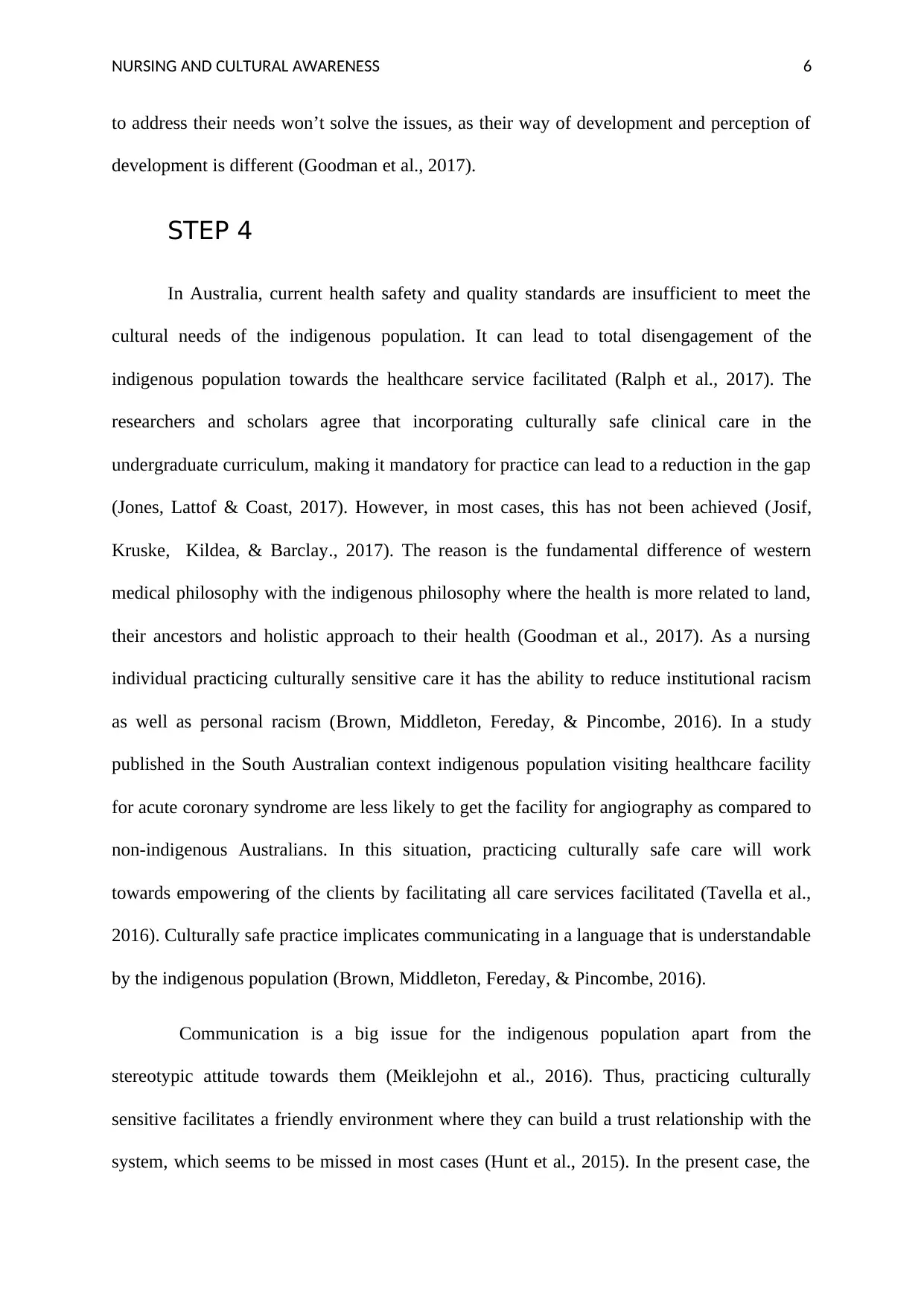
NURSING AND CULTURAL AWARENESS 6
to address their needs won’t solve the issues, as their way of development and perception of
development is different (Goodman et al., 2017).
STEP 4
In Australia, current health safety and quality standards are insufficient to meet the
cultural needs of the indigenous population. It can lead to total disengagement of the
indigenous population towards the healthcare service facilitated (Ralph et al., 2017). The
researchers and scholars agree that incorporating culturally safe clinical care in the
undergraduate curriculum, making it mandatory for practice can lead to a reduction in the gap
(Jones, Lattof & Coast, 2017). However, in most cases, this has not been achieved (Josif,
Kruske, Kildea, & Barclay., 2017). The reason is the fundamental difference of western
medical philosophy with the indigenous philosophy where the health is more related to land,
their ancestors and holistic approach to their health (Goodman et al., 2017). As a nursing
individual practicing culturally sensitive care it has the ability to reduce institutional racism
as well as personal racism (Brown, Middleton, Fereday, & Pincombe, 2016). In a study
published in the South Australian context indigenous population visiting healthcare facility
for acute coronary syndrome are less likely to get the facility for angiography as compared to
non-indigenous Australians. In this situation, practicing culturally safe care will work
towards empowering of the clients by facilitating all care services facilitated (Tavella et al.,
2016). Culturally safe practice implicates communicating in a language that is understandable
by the indigenous population (Brown, Middleton, Fereday, & Pincombe, 2016).
Communication is a big issue for the indigenous population apart from the
stereotypic attitude towards them (Meiklejohn et al., 2016). Thus, practicing culturally
sensitive facilitates a friendly environment where they can build a trust relationship with the
system, which seems to be missed in most cases (Hunt et al., 2015). In the present case, the
to address their needs won’t solve the issues, as their way of development and perception of
development is different (Goodman et al., 2017).
STEP 4
In Australia, current health safety and quality standards are insufficient to meet the
cultural needs of the indigenous population. It can lead to total disengagement of the
indigenous population towards the healthcare service facilitated (Ralph et al., 2017). The
researchers and scholars agree that incorporating culturally safe clinical care in the
undergraduate curriculum, making it mandatory for practice can lead to a reduction in the gap
(Jones, Lattof & Coast, 2017). However, in most cases, this has not been achieved (Josif,
Kruske, Kildea, & Barclay., 2017). The reason is the fundamental difference of western
medical philosophy with the indigenous philosophy where the health is more related to land,
their ancestors and holistic approach to their health (Goodman et al., 2017). As a nursing
individual practicing culturally sensitive care it has the ability to reduce institutional racism
as well as personal racism (Brown, Middleton, Fereday, & Pincombe, 2016). In a study
published in the South Australian context indigenous population visiting healthcare facility
for acute coronary syndrome are less likely to get the facility for angiography as compared to
non-indigenous Australians. In this situation, practicing culturally safe care will work
towards empowering of the clients by facilitating all care services facilitated (Tavella et al.,
2016). Culturally safe practice implicates communicating in a language that is understandable
by the indigenous population (Brown, Middleton, Fereday, & Pincombe, 2016).
Communication is a big issue for the indigenous population apart from the
stereotypic attitude towards them (Meiklejohn et al., 2016). Thus, practicing culturally
sensitive facilitates a friendly environment where they can build a trust relationship with the
system, which seems to be missed in most cases (Hunt et al., 2015). In the present case, the
Paraphrase This Document
Need a fresh take? Get an instant paraphrase of this document with our AI Paraphraser
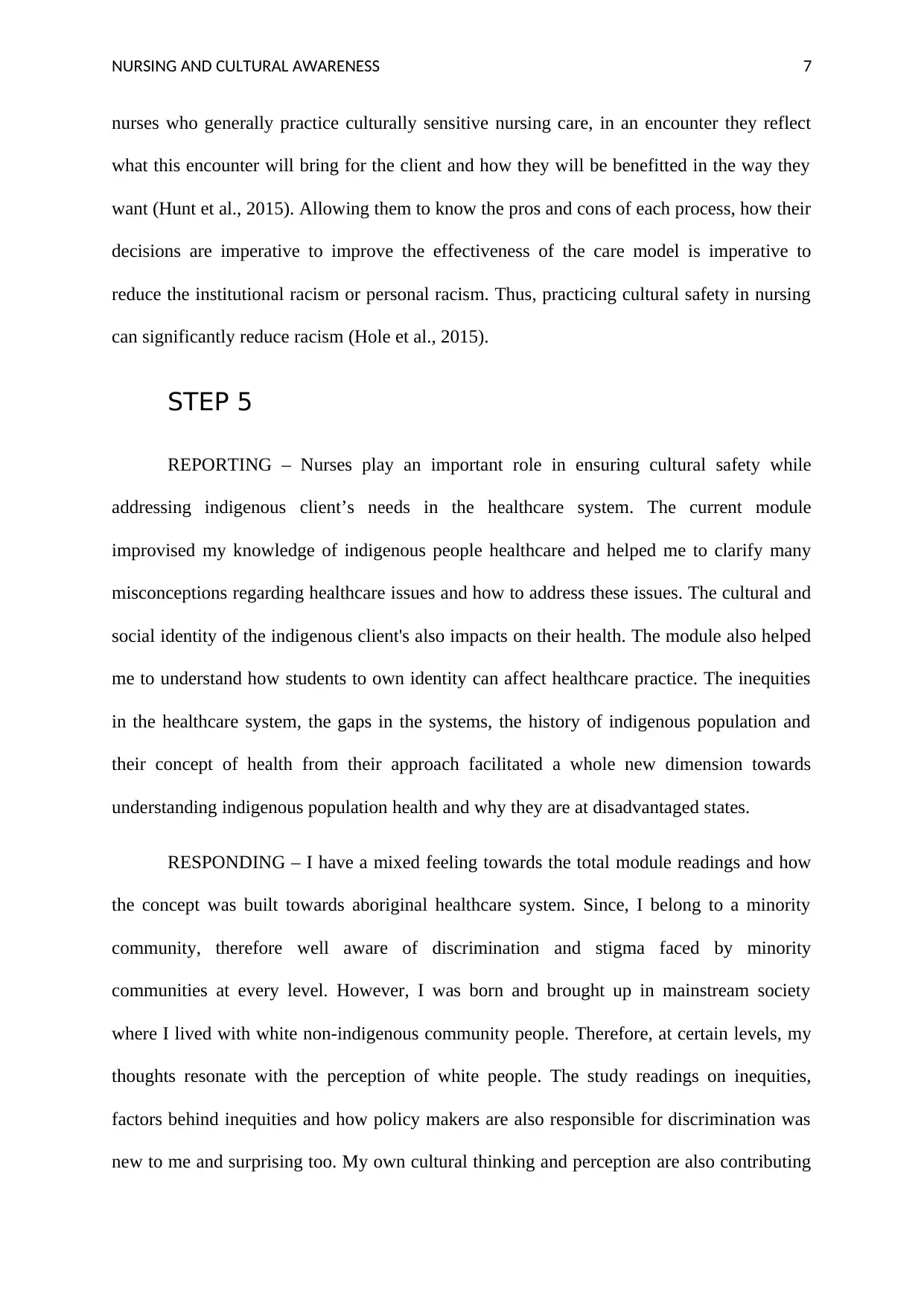
NURSING AND CULTURAL AWARENESS 7
nurses who generally practice culturally sensitive nursing care, in an encounter they reflect
what this encounter will bring for the client and how they will be benefitted in the way they
want (Hunt et al., 2015). Allowing them to know the pros and cons of each process, how their
decisions are imperative to improve the effectiveness of the care model is imperative to
reduce the institutional racism or personal racism. Thus, practicing cultural safety in nursing
can significantly reduce racism (Hole et al., 2015).
STEP 5
REPORTING – Nurses play an important role in ensuring cultural safety while
addressing indigenous client’s needs in the healthcare system. The current module
improvised my knowledge of indigenous people healthcare and helped me to clarify many
misconceptions regarding healthcare issues and how to address these issues. The cultural and
social identity of the indigenous client's also impacts on their health. The module also helped
me to understand how students to own identity can affect healthcare practice. The inequities
in the healthcare system, the gaps in the systems, the history of indigenous population and
their concept of health from their approach facilitated a whole new dimension towards
understanding indigenous population health and why they are at disadvantaged states.
RESPONDING – I have a mixed feeling towards the total module readings and how
the concept was built towards aboriginal healthcare system. Since, I belong to a minority
community, therefore well aware of discrimination and stigma faced by minority
communities at every level. However, I was born and brought up in mainstream society
where I lived with white non-indigenous community people. Therefore, at certain levels, my
thoughts resonate with the perception of white people. The study readings on inequities,
factors behind inequities and how policy makers are also responsible for discrimination was
new to me and surprising too. My own cultural thinking and perception are also contributing
nurses who generally practice culturally sensitive nursing care, in an encounter they reflect
what this encounter will bring for the client and how they will be benefitted in the way they
want (Hunt et al., 2015). Allowing them to know the pros and cons of each process, how their
decisions are imperative to improve the effectiveness of the care model is imperative to
reduce the institutional racism or personal racism. Thus, practicing cultural safety in nursing
can significantly reduce racism (Hole et al., 2015).
STEP 5
REPORTING – Nurses play an important role in ensuring cultural safety while
addressing indigenous client’s needs in the healthcare system. The current module
improvised my knowledge of indigenous people healthcare and helped me to clarify many
misconceptions regarding healthcare issues and how to address these issues. The cultural and
social identity of the indigenous client's also impacts on their health. The module also helped
me to understand how students to own identity can affect healthcare practice. The inequities
in the healthcare system, the gaps in the systems, the history of indigenous population and
their concept of health from their approach facilitated a whole new dimension towards
understanding indigenous population health and why they are at disadvantaged states.
RESPONDING – I have a mixed feeling towards the total module readings and how
the concept was built towards aboriginal healthcare system. Since, I belong to a minority
community, therefore well aware of discrimination and stigma faced by minority
communities at every level. However, I was born and brought up in mainstream society
where I lived with white non-indigenous community people. Therefore, at certain levels, my
thoughts resonate with the perception of white people. The study readings on inequities,
factors behind inequities and how policy makers are also responsible for discrimination was
new to me and surprising too. My own cultural thinking and perception are also contributing
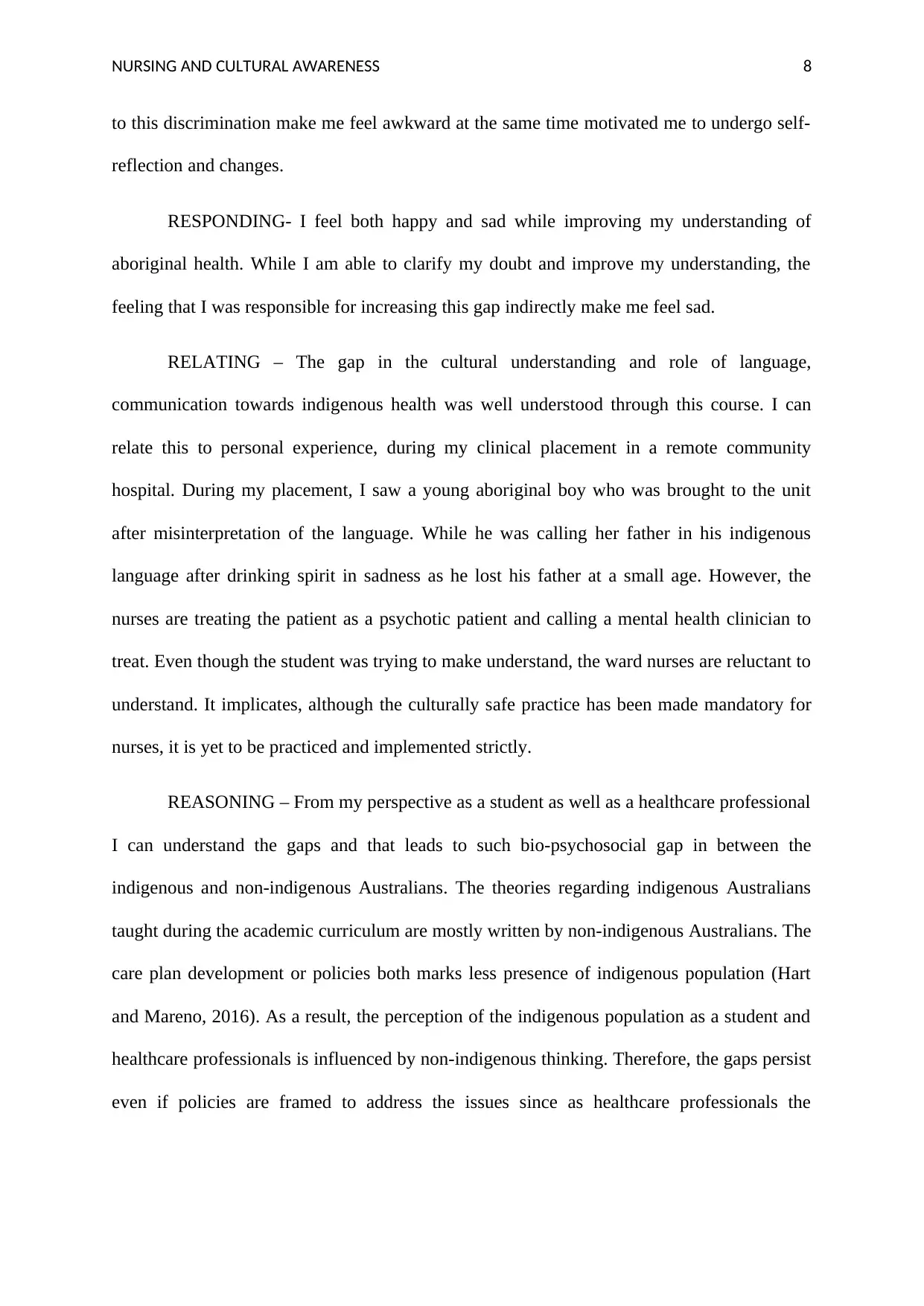
NURSING AND CULTURAL AWARENESS 8
to this discrimination make me feel awkward at the same time motivated me to undergo self-
reflection and changes.
RESPONDING- I feel both happy and sad while improving my understanding of
aboriginal health. While I am able to clarify my doubt and improve my understanding, the
feeling that I was responsible for increasing this gap indirectly make me feel sad.
RELATING – The gap in the cultural understanding and role of language,
communication towards indigenous health was well understood through this course. I can
relate this to personal experience, during my clinical placement in a remote community
hospital. During my placement, I saw a young aboriginal boy who was brought to the unit
after misinterpretation of the language. While he was calling her father in his indigenous
language after drinking spirit in sadness as he lost his father at a small age. However, the
nurses are treating the patient as a psychotic patient and calling a mental health clinician to
treat. Even though the student was trying to make understand, the ward nurses are reluctant to
understand. It implicates, although the culturally safe practice has been made mandatory for
nurses, it is yet to be practiced and implemented strictly.
REASONING – From my perspective as a student as well as a healthcare professional
I can understand the gaps and that leads to such bio-psychosocial gap in between the
indigenous and non-indigenous Australians. The theories regarding indigenous Australians
taught during the academic curriculum are mostly written by non-indigenous Australians. The
care plan development or policies both marks less presence of indigenous population (Hart
and Mareno, 2016). As a result, the perception of the indigenous population as a student and
healthcare professionals is influenced by non-indigenous thinking. Therefore, the gaps persist
even if policies are framed to address the issues since as healthcare professionals the
to this discrimination make me feel awkward at the same time motivated me to undergo self-
reflection and changes.
RESPONDING- I feel both happy and sad while improving my understanding of
aboriginal health. While I am able to clarify my doubt and improve my understanding, the
feeling that I was responsible for increasing this gap indirectly make me feel sad.
RELATING – The gap in the cultural understanding and role of language,
communication towards indigenous health was well understood through this course. I can
relate this to personal experience, during my clinical placement in a remote community
hospital. During my placement, I saw a young aboriginal boy who was brought to the unit
after misinterpretation of the language. While he was calling her father in his indigenous
language after drinking spirit in sadness as he lost his father at a small age. However, the
nurses are treating the patient as a psychotic patient and calling a mental health clinician to
treat. Even though the student was trying to make understand, the ward nurses are reluctant to
understand. It implicates, although the culturally safe practice has been made mandatory for
nurses, it is yet to be practiced and implemented strictly.
REASONING – From my perspective as a student as well as a healthcare professional
I can understand the gaps and that leads to such bio-psychosocial gap in between the
indigenous and non-indigenous Australians. The theories regarding indigenous Australians
taught during the academic curriculum are mostly written by non-indigenous Australians. The
care plan development or policies both marks less presence of indigenous population (Hart
and Mareno, 2016). As a result, the perception of the indigenous population as a student and
healthcare professionals is influenced by non-indigenous thinking. Therefore, the gaps persist
even if policies are framed to address the issues since as healthcare professionals the
⊘ This is a preview!⊘
Do you want full access?
Subscribe today to unlock all pages.

Trusted by 1+ million students worldwide
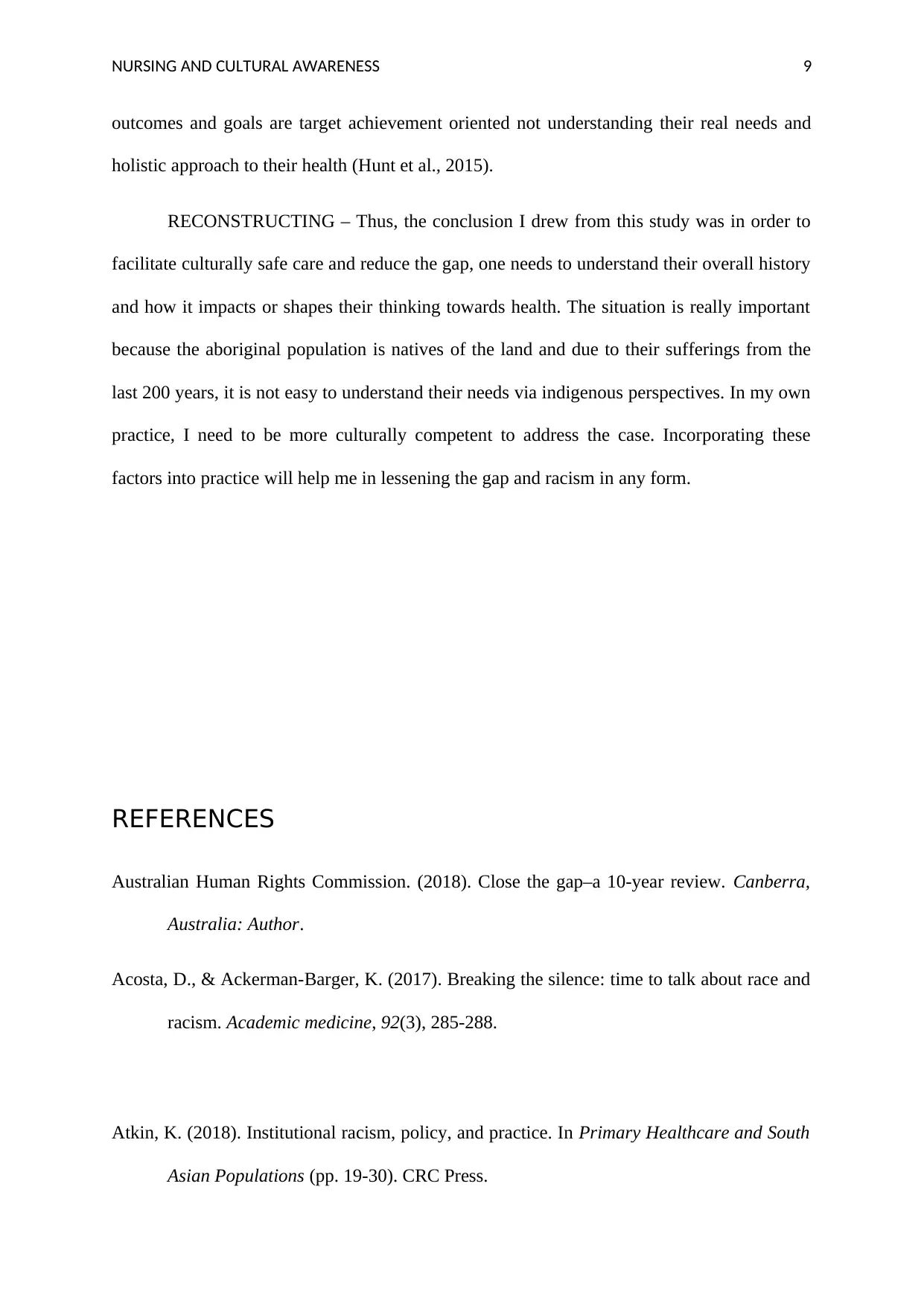
NURSING AND CULTURAL AWARENESS 9
outcomes and goals are target achievement oriented not understanding their real needs and
holistic approach to their health (Hunt et al., 2015).
RECONSTRUCTING – Thus, the conclusion I drew from this study was in order to
facilitate culturally safe care and reduce the gap, one needs to understand their overall history
and how it impacts or shapes their thinking towards health. The situation is really important
because the aboriginal population is natives of the land and due to their sufferings from the
last 200 years, it is not easy to understand their needs via indigenous perspectives. In my own
practice, I need to be more culturally competent to address the case. Incorporating these
factors into practice will help me in lessening the gap and racism in any form.
REFERENCES
Australian Human Rights Commission. (2018). Close the gap–a 10-year review. Canberra,
Australia: Author.
Acosta, D., & Ackerman-Barger, K. (2017). Breaking the silence: time to talk about race and
racism. Academic medicine, 92(3), 285-288.
Atkin, K. (2018). Institutional racism, policy, and practice. In Primary Healthcare and South
Asian Populations (pp. 19-30). CRC Press.
outcomes and goals are target achievement oriented not understanding their real needs and
holistic approach to their health (Hunt et al., 2015).
RECONSTRUCTING – Thus, the conclusion I drew from this study was in order to
facilitate culturally safe care and reduce the gap, one needs to understand their overall history
and how it impacts or shapes their thinking towards health. The situation is really important
because the aboriginal population is natives of the land and due to their sufferings from the
last 200 years, it is not easy to understand their needs via indigenous perspectives. In my own
practice, I need to be more culturally competent to address the case. Incorporating these
factors into practice will help me in lessening the gap and racism in any form.
REFERENCES
Australian Human Rights Commission. (2018). Close the gap–a 10-year review. Canberra,
Australia: Author.
Acosta, D., & Ackerman-Barger, K. (2017). Breaking the silence: time to talk about race and
racism. Academic medicine, 92(3), 285-288.
Atkin, K. (2018). Institutional racism, policy, and practice. In Primary Healthcare and South
Asian Populations (pp. 19-30). CRC Press.
Paraphrase This Document
Need a fresh take? Get an instant paraphrase of this document with our AI Paraphraser
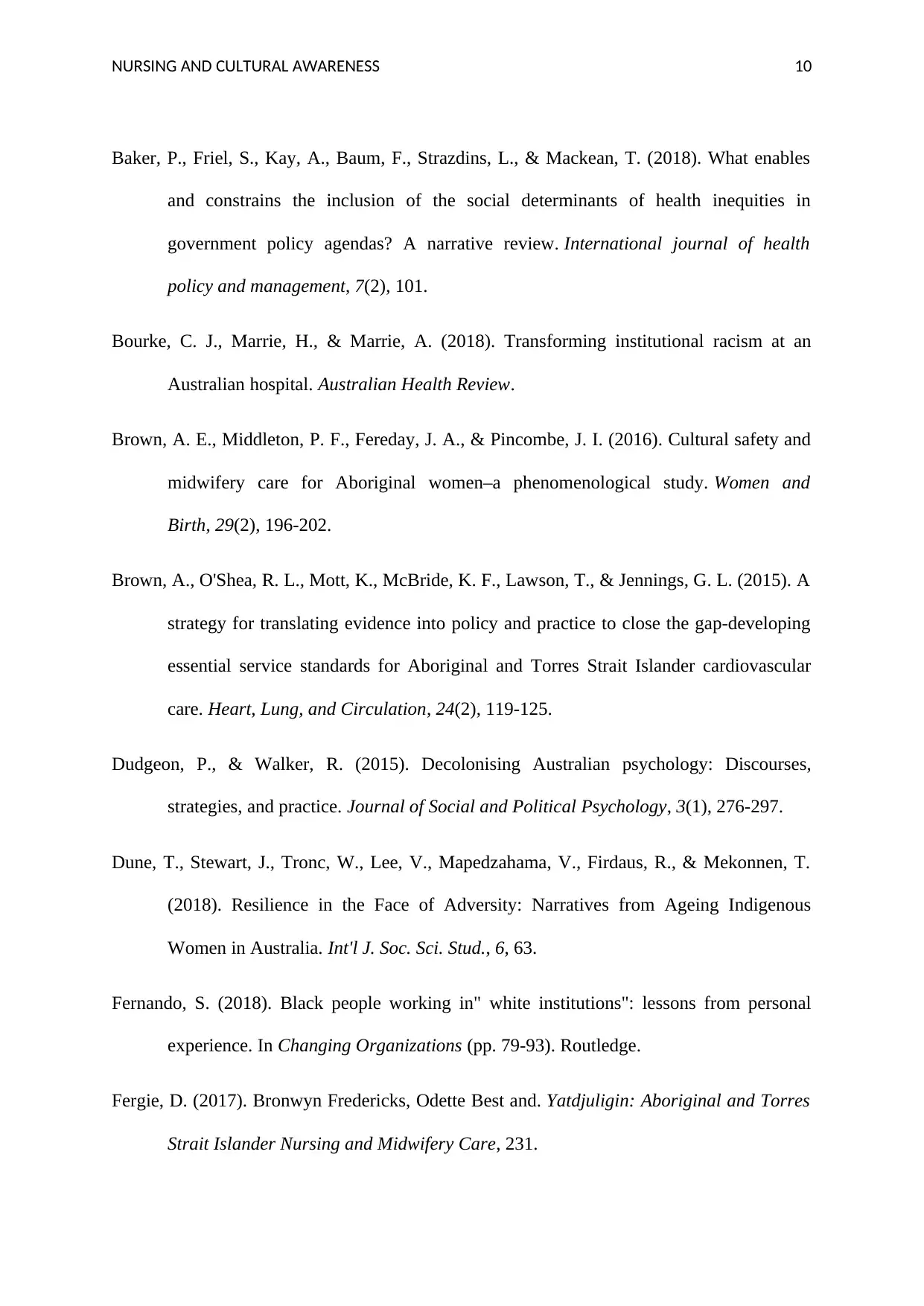
NURSING AND CULTURAL AWARENESS 10
Baker, P., Friel, S., Kay, A., Baum, F., Strazdins, L., & Mackean, T. (2018). What enables
and constrains the inclusion of the social determinants of health inequities in
government policy agendas? A narrative review. International journal of health
policy and management, 7(2), 101.
Bourke, C. J., Marrie, H., & Marrie, A. (2018). Transforming institutional racism at an
Australian hospital. Australian Health Review.
Brown, A. E., Middleton, P. F., Fereday, J. A., & Pincombe, J. I. (2016). Cultural safety and
midwifery care for Aboriginal women–a phenomenological study. Women and
Birth, 29(2), 196-202.
Brown, A., O'Shea, R. L., Mott, K., McBride, K. F., Lawson, T., & Jennings, G. L. (2015). A
strategy for translating evidence into policy and practice to close the gap-developing
essential service standards for Aboriginal and Torres Strait Islander cardiovascular
care. Heart, Lung, and Circulation, 24(2), 119-125.
Dudgeon, P., & Walker, R. (2015). Decolonising Australian psychology: Discourses,
strategies, and practice. Journal of Social and Political Psychology, 3(1), 276-297.
Dune, T., Stewart, J., Tronc, W., Lee, V., Mapedzahama, V., Firdaus, R., & Mekonnen, T.
(2018). Resilience in the Face of Adversity: Narratives from Ageing Indigenous
Women in Australia. Int'l J. Soc. Sci. Stud., 6, 63.
Fernando, S. (2018). Black people working in" white institutions": lessons from personal
experience. In Changing Organizations (pp. 79-93). Routledge.
Fergie, D. (2017). Bronwyn Fredericks, Odette Best and. Yatdjuligin: Aboriginal and Torres
Strait Islander Nursing and Midwifery Care, 231.
Baker, P., Friel, S., Kay, A., Baum, F., Strazdins, L., & Mackean, T. (2018). What enables
and constrains the inclusion of the social determinants of health inequities in
government policy agendas? A narrative review. International journal of health
policy and management, 7(2), 101.
Bourke, C. J., Marrie, H., & Marrie, A. (2018). Transforming institutional racism at an
Australian hospital. Australian Health Review.
Brown, A. E., Middleton, P. F., Fereday, J. A., & Pincombe, J. I. (2016). Cultural safety and
midwifery care for Aboriginal women–a phenomenological study. Women and
Birth, 29(2), 196-202.
Brown, A., O'Shea, R. L., Mott, K., McBride, K. F., Lawson, T., & Jennings, G. L. (2015). A
strategy for translating evidence into policy and practice to close the gap-developing
essential service standards for Aboriginal and Torres Strait Islander cardiovascular
care. Heart, Lung, and Circulation, 24(2), 119-125.
Dudgeon, P., & Walker, R. (2015). Decolonising Australian psychology: Discourses,
strategies, and practice. Journal of Social and Political Psychology, 3(1), 276-297.
Dune, T., Stewart, J., Tronc, W., Lee, V., Mapedzahama, V., Firdaus, R., & Mekonnen, T.
(2018). Resilience in the Face of Adversity: Narratives from Ageing Indigenous
Women in Australia. Int'l J. Soc. Sci. Stud., 6, 63.
Fernando, S. (2018). Black people working in" white institutions": lessons from personal
experience. In Changing Organizations (pp. 79-93). Routledge.
Fergie, D. (2017). Bronwyn Fredericks, Odette Best and. Yatdjuligin: Aboriginal and Torres
Strait Islander Nursing and Midwifery Care, 231.
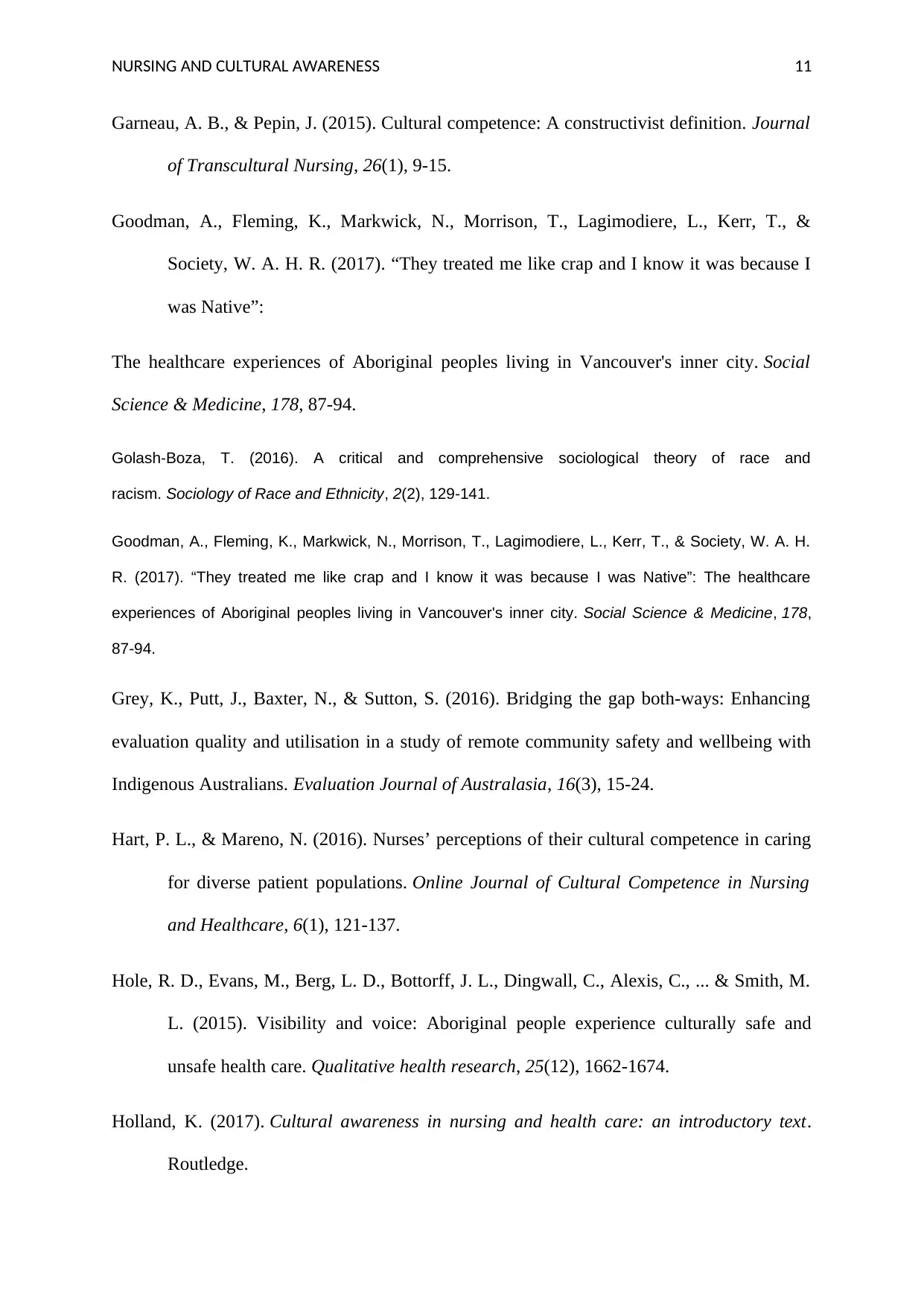
NURSING AND CULTURAL AWARENESS 11
Garneau, A. B., & Pepin, J. (2015). Cultural competence: A constructivist definition. Journal
of Transcultural Nursing, 26(1), 9-15.
Goodman, A., Fleming, K., Markwick, N., Morrison, T., Lagimodiere, L., Kerr, T., &
Society, W. A. H. R. (2017). “They treated me like crap and I know it was because I
was Native”:
The healthcare experiences of Aboriginal peoples living in Vancouver's inner city. Social
Science & Medicine, 178, 87-94.
Golash-Boza, T. (2016). A critical and comprehensive sociological theory of race and
racism. Sociology of Race and Ethnicity, 2(2), 129-141.
Goodman, A., Fleming, K., Markwick, N., Morrison, T., Lagimodiere, L., Kerr, T., & Society, W. A. H.
R. (2017). “They treated me like crap and I know it was because I was Native”: The healthcare
experiences of Aboriginal peoples living in Vancouver's inner city. Social Science & Medicine, 178,
87-94.
Grey, K., Putt, J., Baxter, N., & Sutton, S. (2016). Bridging the gap both-ways: Enhancing
evaluation quality and utilisation in a study of remote community safety and wellbeing with
Indigenous Australians. Evaluation Journal of Australasia, 16(3), 15-24.
Hart, P. L., & Mareno, N. (2016). Nurses’ perceptions of their cultural competence in caring
for diverse patient populations. Online Journal of Cultural Competence in Nursing
and Healthcare, 6(1), 121-137.
Hole, R. D., Evans, M., Berg, L. D., Bottorff, J. L., Dingwall, C., Alexis, C., ... & Smith, M.
L. (2015). Visibility and voice: Aboriginal people experience culturally safe and
unsafe health care. Qualitative health research, 25(12), 1662-1674.
Holland, K. (2017). Cultural awareness in nursing and health care: an introductory text.
Routledge.
Garneau, A. B., & Pepin, J. (2015). Cultural competence: A constructivist definition. Journal
of Transcultural Nursing, 26(1), 9-15.
Goodman, A., Fleming, K., Markwick, N., Morrison, T., Lagimodiere, L., Kerr, T., &
Society, W. A. H. R. (2017). “They treated me like crap and I know it was because I
was Native”:
The healthcare experiences of Aboriginal peoples living in Vancouver's inner city. Social
Science & Medicine, 178, 87-94.
Golash-Boza, T. (2016). A critical and comprehensive sociological theory of race and
racism. Sociology of Race and Ethnicity, 2(2), 129-141.
Goodman, A., Fleming, K., Markwick, N., Morrison, T., Lagimodiere, L., Kerr, T., & Society, W. A. H.
R. (2017). “They treated me like crap and I know it was because I was Native”: The healthcare
experiences of Aboriginal peoples living in Vancouver's inner city. Social Science & Medicine, 178,
87-94.
Grey, K., Putt, J., Baxter, N., & Sutton, S. (2016). Bridging the gap both-ways: Enhancing
evaluation quality and utilisation in a study of remote community safety and wellbeing with
Indigenous Australians. Evaluation Journal of Australasia, 16(3), 15-24.
Hart, P. L., & Mareno, N. (2016). Nurses’ perceptions of their cultural competence in caring
for diverse patient populations. Online Journal of Cultural Competence in Nursing
and Healthcare, 6(1), 121-137.
Hole, R. D., Evans, M., Berg, L. D., Bottorff, J. L., Dingwall, C., Alexis, C., ... & Smith, M.
L. (2015). Visibility and voice: Aboriginal people experience culturally safe and
unsafe health care. Qualitative health research, 25(12), 1662-1674.
Holland, K. (2017). Cultural awareness in nursing and health care: an introductory text.
Routledge.
⊘ This is a preview!⊘
Do you want full access?
Subscribe today to unlock all pages.

Trusted by 1+ million students worldwide
1 out of 14
Related Documents
Your All-in-One AI-Powered Toolkit for Academic Success.
+13062052269
info@desklib.com
Available 24*7 on WhatsApp / Email
![[object Object]](/_next/static/media/star-bottom.7253800d.svg)
Unlock your academic potential
Copyright © 2020–2025 A2Z Services. All Rights Reserved. Developed and managed by ZUCOL.




